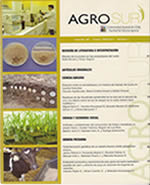Intercultivo de maíz forrajero: producción de materia seca, desarrollo fenológico y calidad nutritiva de cinco gramíneas suplementarias de invierno
Contenido principal del artículo
Resumen
Este trabajo evaluó la producción de materia seca (MS) y valor nutritivo de cinco gramíneas anuales de crecimiento invernal como alternativas para ser utilizadas en intercultivo de maíz forrajero. El ensayo se realizó en el sur de Chile. Se establecieron 15 parcelas de 222 m2 y se evaluó Lolium multiflorum LAM. var. westerwoldicum (LM), Avena sativa L. (AS), Avena strigosa Schreb. (AT), Secale cereale L. (SC) y Hordeum vulgare L. (HV). Se determinó la producción de MS, relación vaina : lámina : tallo, escala Zadoks y calidad nutritiva. Las fechas de los cortes fueron el 21 de julio, 4 de agosto, 21 de agosto, 4 de septiembre, 21 de septiembre y 1 de octubre de 2017. Los rebrotes se cortaron el 1 de octubre de 2017. El diseño fue de bloques completos al azar con arreglo factorial de 5x6 para los cortes (cinco especies por 6 cortes) y 5×5 para los rebrotes (5 especies por 5 rebrotes). Avena strigosa fue la especie con la mayor producción de MS en los cortes. En los rebrotes LM obtuvo las mayores producciones de MS. En la producción acumulada de cortes más rebrotes LM y AT obtuvieron los mayores rendimientos. En valor nutritivo, LM presentó las mayores concentraciones de proteína cruda (PC), energía metabolizable y menores de fibra detergente neutro y ácido. Por lo contrario, SC y AT fueron las especies con estados fenológicos más avanzados, aumentando su contenido de fibra y consecuentemente, un menor valor nutritivo.

